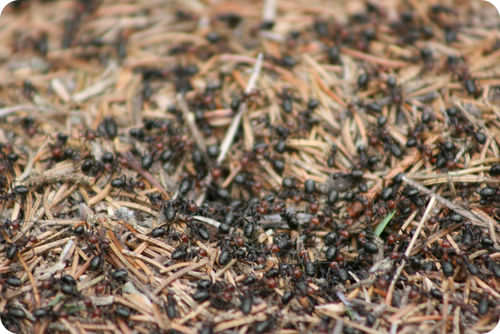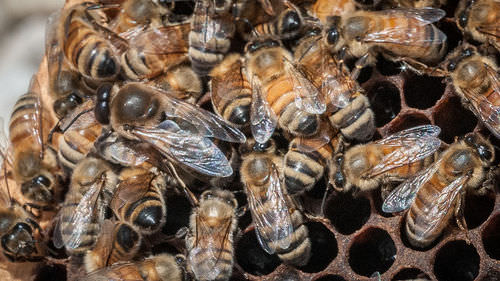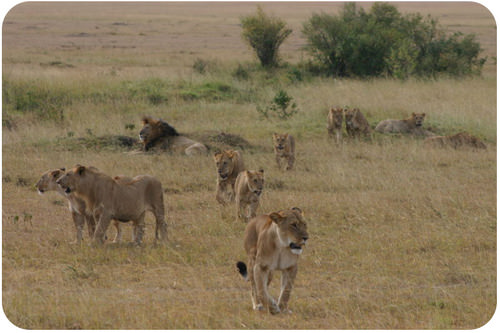8.4: Social Behavior
- Page ID
- 2989
\( \newcommand{\vecs}[1]{\overset { \scriptstyle \rightharpoonup} {\mathbf{#1}} } \)
\( \newcommand{\vecd}[1]{\overset{-\!-\!\rightharpoonup}{\vphantom{a}\smash {#1}}} \)
\( \newcommand{\id}{\mathrm{id}}\) \( \newcommand{\Span}{\mathrm{span}}\)
( \newcommand{\kernel}{\mathrm{null}\,}\) \( \newcommand{\range}{\mathrm{range}\,}\)
\( \newcommand{\RealPart}{\mathrm{Re}}\) \( \newcommand{\ImaginaryPart}{\mathrm{Im}}\)
\( \newcommand{\Argument}{\mathrm{Arg}}\) \( \newcommand{\norm}[1]{\| #1 \|}\)
\( \newcommand{\inner}[2]{\langle #1, #2 \rangle}\)
\( \newcommand{\Span}{\mathrm{span}}\)
\( \newcommand{\id}{\mathrm{id}}\)
\( \newcommand{\Span}{\mathrm{span}}\)
\( \newcommand{\kernel}{\mathrm{null}\,}\)
\( \newcommand{\range}{\mathrm{range}\,}\)
\( \newcommand{\RealPart}{\mathrm{Re}}\)
\( \newcommand{\ImaginaryPart}{\mathrm{Im}}\)
\( \newcommand{\Argument}{\mathrm{Arg}}\)
\( \newcommand{\norm}[1]{\| #1 \|}\)
\( \newcommand{\inner}[2]{\langle #1, #2 \rangle}\)
\( \newcommand{\Span}{\mathrm{span}}\) \( \newcommand{\AA}{\unicode[.8,0]{x212B}}\)
\( \newcommand{\vectorA}[1]{\vec{#1}} % arrow\)
\( \newcommand{\vectorAt}[1]{\vec{\text{#1}}} % arrow\)
\( \newcommand{\vectorB}[1]{\overset { \scriptstyle \rightharpoonup} {\mathbf{#1}} } \)
\( \newcommand{\vectorC}[1]{\textbf{#1}} \)
\( \newcommand{\vectorD}[1]{\overrightarrow{#1}} \)
\( \newcommand{\vectorDt}[1]{\overrightarrow{\text{#1}}} \)
\( \newcommand{\vectE}[1]{\overset{-\!-\!\rightharpoonup}{\vphantom{a}\smash{\mathbf {#1}}}} \)
\( \newcommand{\vecs}[1]{\overset { \scriptstyle \rightharpoonup} {\mathbf{#1}} } \)
\( \newcommand{\vecd}[1]{\overset{-\!-\!\rightharpoonup}{\vphantom{a}\smash {#1}}} \)
\(\newcommand{\avec}{\mathbf a}\) \(\newcommand{\bvec}{\mathbf b}\) \(\newcommand{\cvec}{\mathbf c}\) \(\newcommand{\dvec}{\mathbf d}\) \(\newcommand{\dtil}{\widetilde{\mathbf d}}\) \(\newcommand{\evec}{\mathbf e}\) \(\newcommand{\fvec}{\mathbf f}\) \(\newcommand{\nvec}{\mathbf n}\) \(\newcommand{\pvec}{\mathbf p}\) \(\newcommand{\qvec}{\mathbf q}\) \(\newcommand{\svec}{\mathbf s}\) \(\newcommand{\tvec}{\mathbf t}\) \(\newcommand{\uvec}{\mathbf u}\) \(\newcommand{\vvec}{\mathbf v}\) \(\newcommand{\wvec}{\mathbf w}\) \(\newcommand{\xvec}{\mathbf x}\) \(\newcommand{\yvec}{\mathbf y}\) \(\newcommand{\zvec}{\mathbf z}\) \(\newcommand{\rvec}{\mathbf r}\) \(\newcommand{\mvec}{\mathbf m}\) \(\newcommand{\zerovec}{\mathbf 0}\) \(\newcommand{\onevec}{\mathbf 1}\) \(\newcommand{\real}{\mathbb R}\) \(\newcommand{\twovec}[2]{\left[\begin{array}{r}#1 \\ #2 \end{array}\right]}\) \(\newcommand{\ctwovec}[2]{\left[\begin{array}{c}#1 \\ #2 \end{array}\right]}\) \(\newcommand{\threevec}[3]{\left[\begin{array}{r}#1 \\ #2 \\ #3 \end{array}\right]}\) \(\newcommand{\cthreevec}[3]{\left[\begin{array}{c}#1 \\ #2 \\ #3 \end{array}\right]}\) \(\newcommand{\fourvec}[4]{\left[\begin{array}{r}#1 \\ #2 \\ #3 \\ #4 \end{array}\right]}\) \(\newcommand{\cfourvec}[4]{\left[\begin{array}{c}#1 \\ #2 \\ #3 \\ #4 \end{array}\right]}\) \(\newcommand{\fivevec}[5]{\left[\begin{array}{r}#1 \\ #2 \\ #3 \\ #4 \\ #5 \\ \end{array}\right]}\) \(\newcommand{\cfivevec}[5]{\left[\begin{array}{c}#1 \\ #2 \\ #3 \\ #4 \\ #5 \\ \end{array}\right]}\) \(\newcommand{\mattwo}[4]{\left[\begin{array}{rr}#1 \amp #2 \\ #3 \amp #4 \\ \end{array}\right]}\) \(\newcommand{\laspan}[1]{\text{Span}\{#1\}}\) \(\newcommand{\bcal}{\cal B}\) \(\newcommand{\ccal}{\cal C}\) \(\newcommand{\scal}{\cal S}\) \(\newcommand{\wcal}{\cal W}\) \(\newcommand{\ecal}{\cal E}\) \(\newcommand{\coords}[2]{\left\{#1\right\}_{#2}}\) \(\newcommand{\gray}[1]{\color{gray}{#1}}\) \(\newcommand{\lgray}[1]{\color{lightgray}{#1}}\) \(\newcommand{\rank}{\operatorname{rank}}\) \(\newcommand{\row}{\text{Row}}\) \(\newcommand{\col}{\text{Col}}\) \(\renewcommand{\row}{\text{Row}}\) \(\newcommand{\nul}{\text{Nul}}\) \(\newcommand{\var}{\text{Var}}\) \(\newcommand{\corr}{\text{corr}}\) \(\newcommand{\len}[1]{\left|#1\right|}\) \(\newcommand{\bbar}{\overline{\bvec}}\) \(\newcommand{\bhat}{\widehat{\bvec}}\) \(\newcommand{\bperp}{\bvec^\perp}\) \(\newcommand{\xhat}{\widehat{\xvec}}\) \(\newcommand{\vhat}{\widehat{\vvec}}\) \(\newcommand{\uhat}{\widehat{\uvec}}\) \(\newcommand{\what}{\widehat{\wvec}}\) \(\newcommand{\Sighat}{\widehat{\Sigma}}\) \(\newcommand{\lt}{<}\) \(\newcommand{\gt}{>}\) \(\newcommand{\amp}{&}\) \(\definecolor{fillinmathshade}{gray}{0.9}\)
How are you social?
When you think about being social, do you think about hanging out and chatting with friends? Sending a text or posting to Facebook? Humans socialize in many ways. Social behavior is not limited to humans, however. Many animals are social.
Social Behavior
Why is animal communication important? Without it, animals would not be able to live together in groups. Animals that live in groups with other members of their species are called social animals. Social animals include many species of insects, birds, and mammals. Specific examples of social animals are ants, bees, crows, wolves, lions, and humans. To live together with one another, these animals must be able to share information.
Highly Social Animals
Some species of animals are very social. In these species, members of the group depend completely on one another. Different animals within the group have different jobs. Therefore, group members must work together for the good of all. Most species of ants and bees are highly social animals.
Ants live together in large groups called colonies (Figure below). A colony may have millions of ants, making communication among the ants very important. All of the ants in the colony work together as a single unit. Each ant has a specific job, and most of the ants are workers. Their job is to build and repair the colony’s nest. Worker ants also leave the nest to find food for themselves and other colony members. The workers care for the young as well. Other ants in the colony are soldiers. They defend the colony against predators. Each colony also has a queen. Her only job is to lay eggs. She may lay millions of eggs each month. A few ants in the colony are called drones. They are the only male ants in the colony. Their job is to mate with the queen.

Honeybees and bumblebees also live in colonies (Figure below). Each bee in the colony has a particular job. Most of the bees are workers. Young worker bees clean the colony’s hive and feed the young. Older worker bees build the waxy honeycomb or guard the hive. The oldest workers leave the hive to find food. Each colony usually has one queen that lays eggs. The colony also has a small number of male drones. They mate with the queen.

Cooperation
Ants, bees, and other social animals must cooperate. Cooperation means working together with others. Members of the group may cooperate by sharing food. They may also cooperate by defending each other. Look at the ants pictured below (Figure below). They show very clearly why cooperation is important. A single ant would not be able to carry this large caterpillar back to the nest to feed the other ants. With cooperation, the job is easy.

Animals in many other species cooperate. For example, lions live in groups called prides (Figure below). All the lions in the pride cooperate, though there is still serious competition among the males. Male lions work together to defend the other lions in the pride. Female lions work together to hunt. Then, they share the meat with other pride members.
Another example of cooperation is seen with meerkats. Meerkats are small mammals that live in Africa. They also live in groups and cooperate with one another. For example, young female meerkats act as babysitters. They take care of the baby meerkats while their parents are away looking for food.

Summary
- Social animals, or animals that live in groups with other members of their species, include ants, bees, crows, wolves, and humans.
- Social animals must cooperate (work together) with others.
Explore More
Use the resource below to answer the questions that follow.
- Wolf Hunting Tactics at http://www.youtube.com/watch?v=2jXxtQRy47A (2:54)
- Observe the wolves (Canis lupus) in this video:
- Do you think they are displaying learned behavior, innate behavior, or both? Explain your reasoning fully.
- As social animals, which behavior do you think is most important to them? Explain your reasoning.
- Does your answer apply to all situations?
Review
- What makes social animals unique?
- Give three examples of social animals.
- What is one example of how social animals cooperate?

